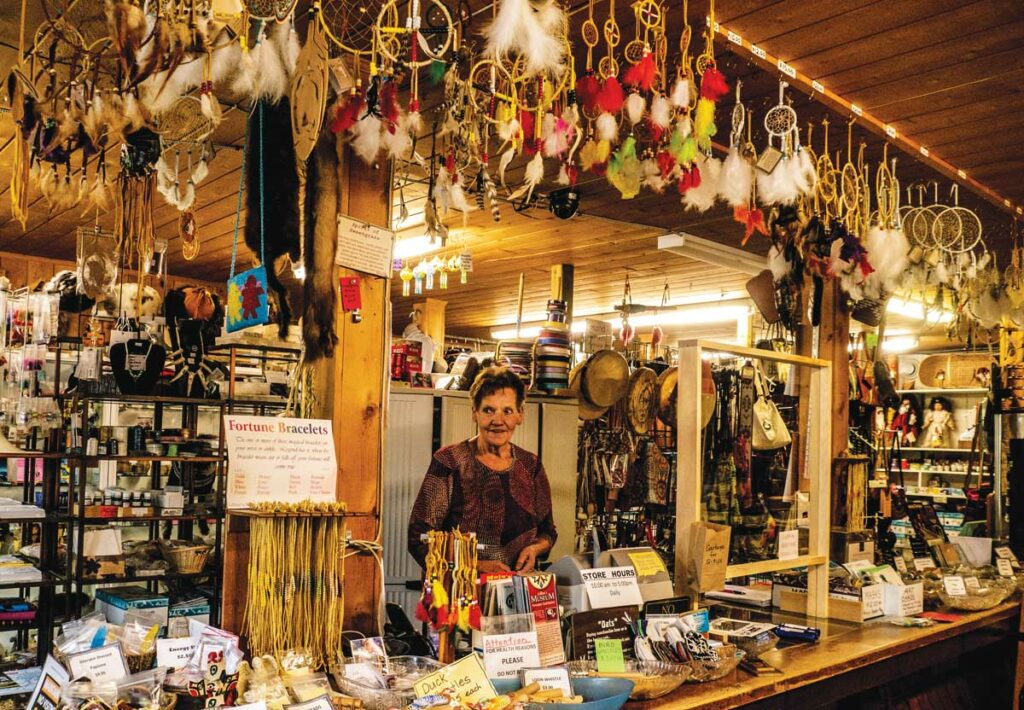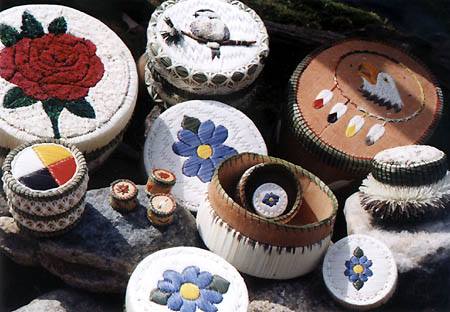By Isobel Harry, This is Manitoulin April 2021
It’s all about love at Lillian’s teeming crafts shop and museum at the crossroads in M’Chigeeng First Nation—the same love for collecting that Lillian Debassige first felt 60 years ago suffuses Lillian’s Crafts and Museum today.
“I started buying baskets in the 1950s,” says Lillian as we tour her museum in the big back room of the overflowing store at the edge of the beach at West Bay. Lillian’s Museum is a collector’s dream, paintings are hung everywhere, glass cases brim with exquisite bead and quill work, walls are stacked high with black ash and pine needle baskets woven with consummate skill and artistry. “I don’t know what it is with baskets,” she says, still a little amazed at what’s she’s gathered over the years. “I just love baskets.”
Lillian, from Kentucky, met Lloyd Debassige from West Bay (now M’Chigeeng) in Chicago and together they came to Lloyd’s Island home in 1962 to buy the building that stood here then. They returned in 1966, this time to stay, and started a restaurant until they tore it down and built the current place so Lillian could open a gift shop. Local basket weavers and crafters would bring their works for her to sell and she ended up buying many for her ever-growing personal collection.
“I wanted to show what I collected; for me, sharing the beauty of the art was the most important part of collecting. There were lots of baskets being made then, and almost none now,” Lillian says, taking in the hundreds of finely crafted pieces of local craftsmanship she acquired over the years. “Baskets are very hard work. The bark of the black ash is removed first, then the log is pounded until the layers of the tree separate into thin ribbons for weaving into baskets. The young kids are not doing this work.”

Painstakingly crafted and decorated quill boxes are highlighted in glass cases centered in the room; small cards bearing photos and names identify the women who made them by hand many years ago. “They’re gone,” says Lillian of her beloved artists of the porcupine quill. “Anne Pangowish, Josette Debassige, Henrietta Toulouse, Mildred Aguonie, Mamie Migwans.” The stunning quill boxes of Mamie Migwans with their shaman figures taken from petroglyphs line one case; the indescribably beautiful tufted quill animals of Rose Williams are startlingly three-dimensional. “You have to be a sculptor to do tufted quills,” Lillian explains as she shows how the quills are placed straight up with the colours arranged in the planned pattern. “Then you sculpt them down.” She demonstrates, waving an imaginary knife above and through them to carve out the final imagery.

But Lillian’s is also an art gallery that is proud to show talented Indigenous artists’ works, most of them in the ‘Woodland School’ style, for sale.
Illuminated against the back wall are large paintings by Leland Bell. “I love Leland’s work. Everyone loves it,” Lillian says of his timeless towering figures in hot blues and oranges and blazing white. Painters Stan Panamick, Blair Debassige, Stephen John, Duncan Pheasant, all vividly represented in nooks and crannies, on walls and shelves, pottery by Carl Beam, Ann Beam, David Migwans and leather work and bone and antler carvings by many other fine artists.
In the shop, Lillian bustles, answering questions and working the cash register. Much is for sale here and in the museum, but Lillian Debassige’s lifetime cultural collection remains a community heirloom beyond price.
Lillian’s Crafts and Museum
5950 Hwy 540
M’Chigeeng First Nation
Tel 705-377-4987
www.lillianscrafts.ca
